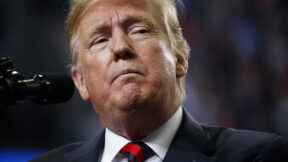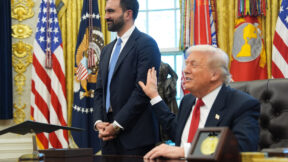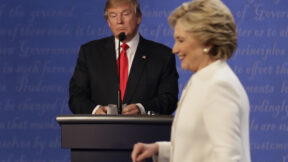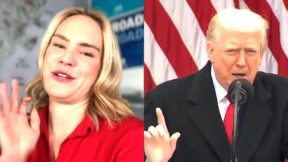EXCLUSIVE: One-on-One With Mark Thompson — The Man Hired to Save CNN
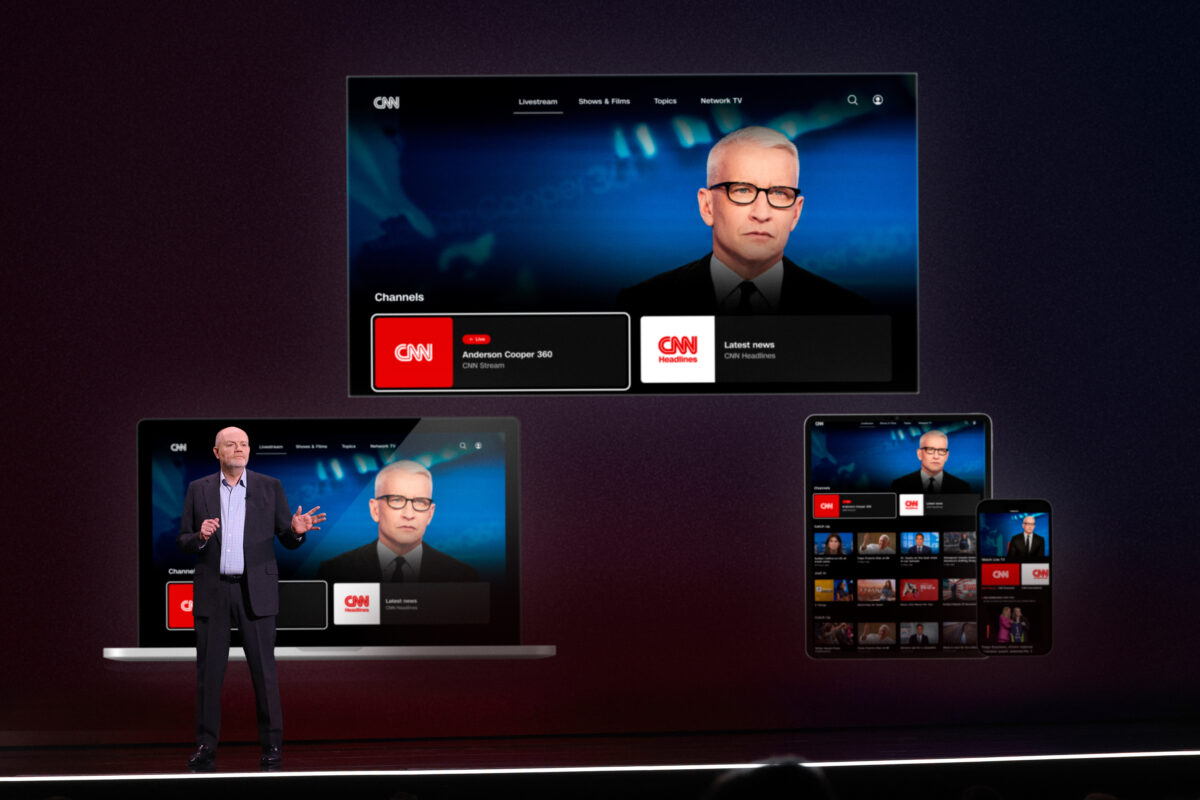
Since taking the helm of CNN two years ago, Sir Mark Thompson—both a British Knight and American citizen—has been something of an enigma to both media observers and even many inside the network itself.
To outsiders, he arrived at a moment when the cable news landscape felt less like a stable institution than a listing ship in stormy seas. Among CNN staffers and talent, he is respected but quietly observed, with a hint of anthropological curiosity, as they examine a new leader who conducts himself very differently from his predecessors when it comes to the spotlight.
In preparation for this interview, I asked around to gauge how people within CNN feel about their CEO. The consensus was simple: “He’s very smart, and he’s very British.” Over the course of our conversation, while he was finishing a KIND bar at his desk, that assessment proved strikingly accurate.
Thompson’s calm demeanor, stiff upper lip, and occasional wry corrections—delivered with the knowing charm of a British headmaster—were on full display as he discussed strategy, programming, and the challenges facing one of the world’s most iconic news brands. Given his limited availability to the press, my role in this conversation felt less about confrontation and more about listening carefully to his vision.
Like every legacy media institution, CNN faces pressures that go far beyond the traditional 24-hour news cycle. Linear television is steadily losing its grip on viewers, cord-cutting accelerates each year, social platforms like TikTok are siphoning attention, and AI threatens to redefine what it means to deliver trustworthy, fact-based news.
In that context, Thompson’s task is monumental: not just to stabilize CNN, but to reimagine it in a world increasingly indifferent to cable news—a challenge best evidenced by CNN’s declining ratings, which I confronted him with right at the top of our interview.
“I want to kind of slightly argue with you,” he said in a reassuring yet precise and confident tone that carried through our conversation. “I would say ratings are not down broadly,” he insisted before explaining, “You know what a rating is — it’s a percentage figure. And actually, so far this year for CNN, it’s probably about 0.31. In 2015, the rating was 0.2.” “So we’re one and a half as big again in ratings as we were 10 years ago,” he added, without boasting. It was a telling example of his approach: factual, methodical, corrective without condescension—yet framed in a more convincing manner than I’ve come to expect from media executives.
Thompson was speaking in terms of CNN’s share of the traditional TV audience, and on that point, his math checks out. Mediaite confirmed his figures with Nielsen data. But the fuller picture of CNN’s reach comes into focus through Nielsen’s new “Big Data” system, introduced in September, which blends traditional panel data with streaming and smart TV viewing. While linear ratings alone paint a less than flattering picture, CNN’s overall penetration—especially across varied digital delivery formats—is more competitive than many traditional snapshots suggest.
*****
Before digging into operational details, Thompson framed the challenge historically, citing his successful stint as CEO of The New York Times. “It sounds silly, but in 2012 people were asking the same question when I arrived at The New York Times—asking the same questions about the Times and the physical newspaper. And although the Times, like CNN, had had a website since the mid-90s, people obviously, quite understandably, said, ‘Yeah, well, you’ve got a website, but honestly, how are you ever going to get that to take the place of your physical newspaper? You’ll never get the economics to work.’”
At the Times, he oversaw a methodical eight-year transition to a profitable, engaged digital audience. The lesson, he noted, was that change is incremental and strategic, not immediate—a lesson he’s now applying to cable television.
A year ago, CNN quietly launched a subscription service, which made few waves in the broader media conversation. Thompson framed it simply: it was a laboratory to understand audience willingness to pay and the mechanics of a subscription product before rolling out a larger streaming platform, which is soon to come. He described the forthcoming launch with patient enthusiasm.
“If you decide you want to become a subscriber to CNN, you’re going to have, in the future, two choices,” he explained. “A basic layer, where you get CNN.com and unlimited access to that. And then a higher level, an ‘All Access’ level, which also gives you the ability to access a close relative of the CNN cable experience and CNN.”
He emphasized that the new platform is being built with existing cable relationships in mind: “This has been created in partnership with our incredibly important and trusted cable affiliate partners, and people who subscribe to those cable services will be able to authenticate for free and access our product,” he said, outlining complexity with no perceptible drama.
He elaborated on the service’s offerings: “This is intended to be a breaking news service of national and international news, with programming and every single on-air anchor currently on CNN domestic cable news being presented. So a real chance—if you cut the cord—this will be a way of getting news back in a way you can watch on a connected TV, or watch on your phone, or pretty much every other digital device.”
*****
The cable platform itself, once a bastion of news distribution, is under growing pressure. Thompson emphasized the scale of the challenge with notable clarity.
“Cable was a fabulous platform for news. Ted Turner was pretty much the first to see that in many ways in 1980. But at the moment, you could argue the finer points, but maybe 77 million households by now have cut the cord and don’t get cable anymore. And that number may change, but let’s imagine an average current rate of about 10% cutting the cord each year. So this platform is no longer an effective platform for reaching much of America. And the task is simply to find pathways for getting CNN—the full CNN experience, which is not just like a website with written news stories, but also Anderson Cooper and the great breaking news—into millions of households who don’t have cable TV, but who still want news.”
His dispassionate framing of these structural pressures—delivered without a hint of hysteria—reflected one of his most British traits: the stiff upper lip. He presents facts plainly, outlines the challenge, and positions CNN’s strategy as deliberate, not reactive.
Central to that strategy is what Thompson repeatedly calls the “full CNN experience,” encompassing live anchors, breaking news, text coverage, and multimedia features. He distinguished this offering from past failed experiments and rival products. “This isn’t a repeat of CNN+, nor is it a Fox Nation–style streaming network,” he explained. “It’s a comprehensive news service, combining text, short-form video, and live programming from anchors such as Anderson Cooper and Jake Tapper. If you cut the cord, you miss news. This will be a way of getting news back in a way you can watch on a connected TV or your phone or pretty much every other digital device.”
I pressed Thompson on the core value proposition—what CNN offers that justifies asking viewers to pay, especially compared to The New York Times, whose marquee bylines like Maggie Haberman (who gets a paycheck from both outlets) provide distinctive value.
His answer was precise and confident. “We want to try to persuade people that the CNN experience of when something important happens, we are on the ground and we are often on the floor before everyone else. We have people that you know and trust who are going to go with you and the camera into the story and report it in real time. You can also get live TV—domestic and international feed—lots of live news feeds. If you want to stick with one story or just simply wait for that press conference, you can watch those directly, unmediated.”
Launching a product of this scale requires a massive promotional effort. Traditionally, CNN’s linear cable platform served as a megaphone, but that megaphone now objectively reaches far fewer people than it did as recently as early 2021. Which brought us back to ratings.
“I don’t want to exaggerate,” he began, “and I have to say, we got some exceptional ratings during COVID, but ratings are actually perfectly healthy.” He contextualized CNN’s current position in the competitive landscape with a mix of candor and data. “Back in 2017 was when MSNBC surged ahead in all the audiences. But by 2023, in the first three quarters of 2023, CNN was only 6% ahead of MSNBC. By the same quarters in 2025, we’re now 51% ahead of MSNBC in the demo, and we’ve halved the gap in all audiences. So we’re performing and highly competitively. Our mornings are much stronger. Even though we had a massive change around in prime and brought lots of new anchors in, new shows, they’re all performing very well competitively.”
*****
CNN’s repositioning to a political center after the so-called anti-Trump “Resistance era” has also drawn scrutiny. I asked him directly whether he believes CNN currently leans left. Thompson deftly answered by framing the network’s approach as measured and fair-minded, apart from the partisan spectrum.
“I don’t think our job is to be in the center. I think our job is to be out of the ring. It’s more about being fair-minded across the political spectrum and recognizing that the best ideas may come actually from the political edges. It’s not for us to say that the only good politics are from the middle. I just want to say, let’s just point the camera at it and interrogate it and ask smart questions. But we’re very comfortable to have a broad range of political voices on the air.”
Pressed again on CNN’s alleged left-leaning bias, Thompson’s response was more pragmatic than defensive. “Well, my view is let’s just do our jobs as journalists. I think the strategy with a strategic advantage for us is around news and around fair-mindedness. You build confidence in that over time.”
Thompson is also clear-eyed about Fox News’ dominance and political identity: “I will be the first person to admit, Fox is a slightly different animal. It’s in some ways a political affinity, a community service for people of one very big, strong political affection.”
When asked how CNN can compete with such a dominant outlet — despite its recently paying $787 million to Dominion Voting Systems to settle a defamation lawsuit — he declined to take the bait: “CNN’s strategic advantage is in news. We are first and foremost fair-minded. We do everything we can to be accurate and timely. People can trust what they hear about the news.”
“Our cable network has a significant Republican and independent audience,” he added, highlighting what he sees as a strength in viewer diversity. “The strategically best positioning for CNN is that we are actually a news service, as opposed to an opinion and debate service masquerading as a news service.”
Beyond ratings and political positioning, Thompson is acutely aware of the social-driven attention economy. He’s equally clear-eyed about the forces reshaping the media landscape, from TikTok/ Instagram to AI. “The ecosystem is changing,” he said. “We’ve got to meet people where they are… That means phones, apps, video that’s digestible and mobile-first… But it’s also got to be news you can trust, not just a feed of bites and headlines.” He neither overstates the threat nor indulges in panic, methodically outlining CNN’s strategy to adapt content to a modern attention economy.
*****
While careful not to overstate his role or take credit for the work of others, Thompson didn’t shy away from discussing his hands-on approach to programming and talent decisions. Abby Phillip’s primetime show has drawn better ratings and criticism for regularly devolving into partisan skirmishes, but Thompson views it differently: as a deliberate effort to experiment with authentic political debate—something increasingly rare in an era dominated by hyper-partisan opinion programming.
I asked what the success of that show says about what CNN viewers tune into and if we should expect more of that moving forward. “I think a more varied primetime experience where people get different flavors is good,” he explained. “I was heavily involved in that re-org of that show. I’m pleased with it as one of maybe the only places on American TV you can actually see genuine MAGA Republicans and strong and vocal Democrats having at it. I think there’s a place for that as well. But to me, the core of the CNN proposition is always and has always been about news.”
“There’s always a risk in cable TV that people say, ‘Well, that one works. Why don’t we do ten of them and see if that works better?'” he added. “I think a more varied primetime experience where people get different flavors is good.”
That same appetite for experimentation is evident in how he’s approached CNN’s primetime lineup more broadly. “I asked Kaitlan Collins to take on the combined role of Chief White House Correspondent and the 9 o’clock anchor,” he offered when asked about his hand in programming. “That’s meant to be a different kind of innovation. She’s in the room where it happens—inside the White House—while anchoring at the same time.”
Supporting on-air talent, especially under political attack from President Donald Trump — like Collins — is also part of his mandate. “We worry always about whether our people are being supported properly… We are closely knit. We support each other… We intend to get through this without diminishing our sense of duty to the public, despite any obstacles that are put in our way,” he said firmly.
Even thornier personnel issues, such as Jim Acosta’s controversial departure, Thompson framed strategically rather than reactively. Some critics claimed his exit amounted to a capitulation to a Trump administration eager to pick fights with CNN. Thompson rejected that characterization: “It was genuinely unconnected. That wasn’t a spot invented for Jim Acosta… I would have been delighted if Jim had said yes.” The plans for an LA-based show that was offered to Acosta continue, suggesting Thompson’s explanation holds. As for other departures, he added, “We have said goodbye to them not because they were bad, but because there wasn’t the work or we took a different view.”
Similarly, his treatment of pundits like Scott Jennings—polarizing but undeniably compelling—illustrates Thompson’s willingness to feature a spectrum of voices. To many on the right, Jennings is a refreshing truth-teller; to much of the left, he’s a provocateur and gaslighter. Thompson sees value in that tension.
“Scott’s like D’Artagnan, he’s got his sword out and he’s got about four Democrats against him, but he spiked them all off. That’s much more like it, I think. He’s a worthy opponent, as it were, for the Democrats in the room,” he added. “And it makes for not just good television, but also for in some ways, a slightly deeper testing of the ideas all the way around that table.”
“I do think the idea of challenge, and of all of us being exposed to perspectives we maybe disagree with and having our own views put to the test, is a healthy thing,” he said. “It makes for not just good television, but also, in some ways, a slightly deeper testing of the ideas all the way around that table.”
Across these examples, Thompson’s beans-on-toast upbringing shows through: no-nonsense, and steady. He makes deliberate decisions, defends his strategy with reason rather than bluster, and sprinkles in an understated humor. He doesn’t need to theatrically assert authority—he’s seems confident that experimentation and principle-driven choices will gradually evolve CNN’s programming, and audience, preferring a pragmatic approach over flashy, attention-grabbing overhauls.
*****
His personal approach to this high-stakes, highly visible task is distinctive: low-profile, calm, and deliberate. “I’m mainly focused on CNN and its success. When we think about journalism as a whole — having one or two bastions of brands and newsrooms that can survive is really important. CNN has got a shot at survival and thriving. There aren’t many, I think, who can do that. So giving it its best shot and focusing on that is only the best use of my time, really.”
Thompson’s vision is less about ego or personal brand-building than disciplined stewardship—a captain guiding a ship through stormy seas with the confidence of someone who’s navigated a rough passage before and emerged not just unscathed, but tested. If he is daunted by high expectations, I honestly didn’t sense it.
There is no denying the anxiety that runs through CNN’s rank and file—stress that can be felt across the media landscape. I entered the conversation with skepticism but came away more impressed than I anticipated. Staffers have shown themselves prone to occasional meltdown, leaking to reporters about what a disaster the network seemed to be after Jeff Zucker’s departure, criticism from top shareholder John Malone, and the rocky tenure of ex-chief Chris Licht.
Two years in, Thompson presents a network in deliberate transformation. From subscriptions to streaming, cable to digital-first formats, talent decisions to political positioning, he exhibits a rational, and precise leadership style. Critics will continue to scrutinize ratings, content, and political leanings—but Thompson’s methodical and experience-steeped approach remains clear.
CNN is not simply trying to survive; it is cautiously navigating a period of transformation under a leader known for a measured, deliberate approach. Thompson’s emphasis on principled decision-making and steady management is evident, though whether he can fully realize this vision remains uncertain. The network’s strategy is in place, but the challenges ahead are significant.
Amid the ominous clouds hanging over every legacy media institution, what comes across most in conversation with Mark Thompson — that is, Sir Mark Thompson, the man described by his charges as “very British” — is that he’s chosen to run his network in accordance with the most famous British mantra of them all: Keep calm and carry on.
